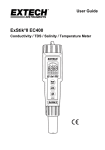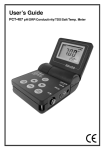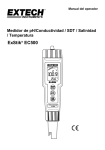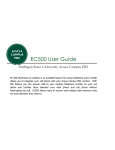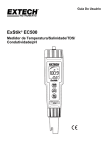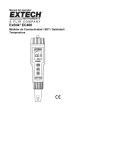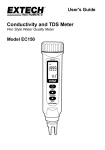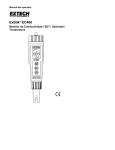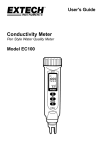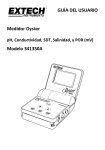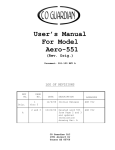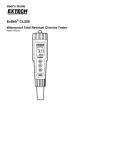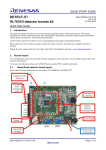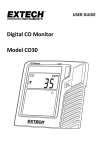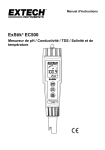Download ExStik® EC500
Transcript
User's Guide ExStik® EC500 pH/Conductivity / TDS / Salinity / Temperature Meter EC500 Introduction ® Congratulations on your purchase of the ExStik EC500 pH/Conductivity/Total Dissolved Solids (TDS) / Salinity meter. With the EC500’s dynamic cell-constant technology it is possible to measure a wide range of Conductivity, TDS, and Salinity with the same electrode. Careful use and maintenance will provide years of reliable service. Powering the ExStik™ ® The ExStik uses four (4) CR2032 Lithium Ion Batteries (included). If the batteries are weak, the ® ‘BAT’ indicator appears on the LCD. Press the ON/OFF key to turn the ExStik on or off. The auto ® power off feature shuts the ExStik off automatically after 10 minutes of inactivity to preserve battery life. Getting Started Remove the cap from the bottom of the ExStik to expose the pH electrode, reference junction and conductivity electrodes. Before the first use or after storage, soak the electrode in tap water or pH 4 buffer solution for about 10 minutes. White KCL crystals may be present in the cap or on the electrode. This is to be expected depending on the length of time in storage. These crystals will dissolve while soaking the electrode or they can be rinsed away with tap water. For best results calibrate with pH 7 buffer solution first, then calibrate with the buffer solution closest to the expected pH value of the solution or material to be tested. To preserve the pH electrode life keep the sponge in the protective cap soaked with tap water or pH 4 buffer solution. For best results, calibrate for conductivity with a standard in the expected range of the sample. For maximum accuracy calibrate from low conductivity value standards to high value standards. 2 EC500-en-GB_v2.6 10/14 Meter Description Front Panel Description 1. Battery compartment cover 2. LCD Display 3. MODE/HOLD button 4. CAL/RECALL button 5. ON/OFF button 6. Electrode Collar 7. pH/Conductivity Electrode (Note: The Electrode cap is not shown) EC500 LCD Display 1. Bargraph display 2. Measurement units 3. Main display 4. Range calibration and low battery indicators 5. Temperature display 6. Renew indicator pH 7. Reading hold indicator 6 7 3 RENEW EC500-en-GB_v2.6 10/14 Measurement Procedure Sample Preparation: 1. For Conductivity, TDS or Salinity place the test sample in a sample cup with enough depth (2.5cm minimum) to cover the electrode. Stir the solution to remove any air bubbles. 2. For pH, place the tip of the electrode in the sample or make contact with a wet surface. Conductivity TDS Salinity PH Measurement: 8888 1. Press the ON button. ( and then “SELF CAL” will appear in the display during the turn-on diagnostics) 2. Depress and hold the MODE/HOLD key to scroll to the desired measurement mode. 3. Insert the electrode into the sample making sure that the electrodes are completely submersed. 4. Slowly stir the solution with the electrode to remove air bubbles if in the Conductivity, TDS or Salinity mode. 5. If in the Conductivity, TDS or Salinity modes, the meter will auto-range to the proper range and then display the reading. (ppm) EC500 (mg/l) mgL pH L M H 4 EC500-en-GB_v2.6 10/14 Changing Measurement Function The meter can be set to measure pH, Conductivity, TDS or Salinity. To change the mode: 1. Press and Hold the MODE/HOLD button for 2 seconds and the display will begin to scroll through the units. µS (Conductivity); pH; ppm S (Salinity); ppm (TDS); mg/l (TDS); Note: The “HOLD” function cannot be on when changing the measurement function. If “HOLD” is displayed in the lower left corner of the display, briefly press the MODE/HOLD button to turn it off. 2. When the desired units are displayed, release the MODE/HOLD button. TDS Compensation Ratio The TDS value is determined by multiplying a conductivity reading by a known ratio factor. The meter allows for selecting a conversion ratio in the range of 0.4 to 1.0. The ratio varies with the application, but is typically set between 0.5 and 0.7. Note: The stored ratio will briefly appear in the lower temperature display when the meter is first turned on, or when changing measurement function to TDS. Note: In the Salinity mode the ratio is 0.4 to 0.6 auto. To change the ratio, while in the TDS measurement mode (ppm or mg/l): 1. Press and release the CAL/RECALL button twice in succession. The stored ratio will appear in the display. 2. Press the MODE/HOLD button to increase the ratio value in steps of 0.1. 3. When the desired ratio is displayed, press and release the CAL/RECALL button to store the value and return to the normal mode. 4. If no buttons are pressed for 5 seconds, the meter returns to measure mode. Storing Readings 1. Press the MODE/HOLD button to store a reading. The storage location number will be displayed on the lower display, while the main display shows the stored reading. The meter will enter the HOLD mode and the “HOLD” indicator will appear. 2. Press the MODE/HOLD button again to exit the HOLD mode and return to normal operation. 3. If more than 25 readings are stored, previously stored readings (starting with number 1) will be overwritten. 5 EC500-en-GB_v2.6 10/14 Recalling Stored Readings 1. Press the CAL/RECALL button and then press the MODE/HOLD button. A location number (1 through 25) will briefly appear and then the value stored in that location will appear. The displayed units will flash, indicating that the storage recall mode is active. 19.5 °C 2. The last stored reading will be displayed first. Pressing and releasing the MODE/HOLD button will scroll through the stored readings one at a time. The location number is displayed first, followed by the reading stored in that location. 3. To exit the storage mode, press the CAL/RECALL button and the meter will return to normal operation, after displaying “End”. Clear Stored Memory With the unit on, press and hold ON/OFF for 4 seconds. “clr” will be briefly displayed when the memory is cleared. Changing Temperature Units o o To change the displayed temperature units ( C or F): 1. With the unit OFF, press and hold down the CAL/RECALL button. 2. With the CAL/RECALL button depressed momentarily press the ON/OFF button. When “SELF CAL” appears in the display release the CAL/RECALL button. The unit will power on with temperature displayed in the new units. Data Hold Mode Press the MODE/HOLD button to hold (freeze) a reading in the display. The meter will enter the HOLD mode and the “HOLD” indicator will appear. Note: This also stores the reading. Press the MODE/HOLD button again to return to normal operation. Auto Power OFF The auto power off feature automatically shuts the meter off 10 minutes after the most recent button press. Auto Power OFF Disengage Feature To disable the Auto Power Off feature: 1. Turn the unit on 2. Press CAL/RECALL once (Quickly) 3. Immediately and simultaneously press the MODE/HOLD and ON/OFF buttons for approximately 2 seconds, until “oFF” is briefly displayed To disengage this feature, turn the unit off with the ON/OFF button. The next time the unit is powered up, Auto Power OFF mode will be engaged again. Low Battery Indication When the batteries become weak the “BAT” icon will appear in the display. Refer to the Maintenance section for battery replacement information. 6 EC500-en-GB_v2.6 10/14 Calibration - pH (1, 2, or 3 points) 1. 2. 3. 4. 5. 6. Place the electrode into a buffer solution (4, 7, or 10). Press and hold the CAL/RECALL key until “CAL” appears in the lower (temp.) display. When doing a 2 or 3 point calibration, calibrate with pH 7 buffer first, then follow with pH 4 then the pH 10 buffer. ® The ExStik automatically recognizes the solution and calibrates itself to that value (the circled number on the LCD will match the solution). Note that if the solution is more than 1 pH unit off ® from the L (4), M (7), or H (10) pH buffer, or if the electrode slope is low, the ExStik will assume an error and abort the calibration (‘End’ will be displayed, and the unit will return to measure mode.) During calibration, the pH reading flashes on the main display. ® When calibration is complete, the ExStik automatically displays “SA”, then “End” and returns to normal operation mode. The appropriate circled indicator (L, M, or H) appears on the LCD when a particular calibration ® or series of calibrations has been completed within one power on cycle. When the ExStik is turned off, the circled indicator configuration and the calibration data will be retained. For a two or three point calibration, repeat steps 1-4. CAL Reminder Display When in pH measurement mode, a “CAL” icon will appear after 15 on/off cycles of the meter without performing a calibration. The CAL display is simply a reminder to calibrate pH, and will turn off when the pH electrode is recalibrated. The reminder does not affect function in any way. RENEW Display A flashing ‘RENEW’ warning indicates that the probe is not performing to expected specifications. If cleaning and recalibration does not cause the RENEW icon to disappear, replace the probe (see optional accessories on the last page of this manual). The RENEW display appears as a result of the pH electrode slope falling below 70% of a nominal slope. Measurement and Display Considerations If the unit appears to be locked (display frozen). It is possible that the Data Hold mode has been inadvertently accessed by pressing the MODE/HOLD button. (“HOLD” will be displayed in the bottom left of the LCD.) Simply press the MODE/HOLD button again or turn the meter off and then on. For maximum accuracy, allow sufficient time for the temperature of the probe to reach the temperature of the sample before calibrating. This will be indicated by a stable temperature reading on the display. 7 EC500-en-GB_v2.6 10/14 Calibration - Conductivity Meter accuracy verification should be performed on a periodic basis. Once per month is the recommended cycle for normal use. If calibration is required, a conductivity standardizing solution must be obtained. The meter can be calibrated in any or all of the three ranges. Standardizing solutions of 84µS/cm, 1413µS/cm or 12.88mS/cm (12,880µS/cm) are used for the automatic calibration recognition procedure. No other calibration values are permitted. Calibration is always done in conductivity mode. Since salinity and TDS values are calculated from conductivity values, this procedure also calibrates the salinity and TDS ranges. 1. 2. 3. 4. 5. Fill a sample cup with the standardizing solution. Turn the meter ON and insert the electrode into the solution. Tap or move the electrode in the sample to dislodge any air bubbles. Press and hold the CAL/RECALL button (approximately 2 seconds) until “CAL” appears in the lower (temp) display. The main display will start flashing. The meter will automatically recognize and calibrate to the standardizing solution. The display will briefly indicate “SA”, End and then return to the measurement mode after a calibration. Note: The “SA” will not appear if the calibration fails. The “range calibrated” symbol will appear in the display for each range that is calibrated during that power on cycle. Low range, 84µS/cm Medium range, 1413µS/cm High range, 12.88mS/cm (12,880µS/cm) Note: Each time the calibration mode is entered all calibration symbols on the display are cleared, but only the calibration data for the currently calibrated range is replaced. The other two ranges keep the existing calibration data, just the symbols are removed. Calibration of all three ranges must be performed during one power on period for all three range calibration symbols to appear. Note: The meter allows for a 1, 2 or 3 point calibration. If calibration is done for more than one point the lowest value standard should be done first to obtain the best accuracy. Considerations and Techniques Do not touch the inner surfaces of the conductivity electrodes. Touching the surface of the platinized electodes may damage and reduce the life of the probe. Store the electrode in the wetting cap with the sponge moistened with pH 4.01 buffer solution. Always rinse the electrode in de-ionized water between measurements to avoid cross contamination of the sample. Double rinsing is recommended when high accuracy is required. Periodically, accumulated salt deposits from the reference electrode may build up in the storage cap, and should be rinsed away. These deposits could affect measured values of low conductivity samples. When measuring low conductivity samples, extra care is recommended in rinsing the probe to avoid contamination of the sample with electrolyte from the pH reference electrode. This will only be a factor when measuring in the low range, and can be further minimized by increasing the volume of the sample. (Example: Try a 200 to 500 mL sample.) If the 20mL sample cup is to be used, then the electrode should not be allowed to sit in the sample for any longer than necessary, to avoid electrolyte leakage into the sample, raising the conductivity value. 8 EC500-en-GB_v2.6 10/14 Operational Matrix Function / Resulting Action On/Off Power Status On or Off Mode Setting Required Key Press Sequence Any Momentary press of the ON/OFF key Calibration On pH or Conductivity Press & hold CAL/RECALL key for 2 seconds, until it enters CAL function Store Reading On Any measure mode Momentary press of the MODE/HOLD key Hold Release On While In Hold Mode Momentary press of the MODE/HOLD key Enter Memory Retrieval On Any measure mode Momentary press of the CAL/RECALL key followed by a momentary press of the MODE/HOLD key (Within 4 seconds) Scroll Stored Readings On Memory Recall Momentary press of the MODE/HOLD key (Displays “last in first out”) Exit Memory Retrieval On Memory Recall Momentary press of the CAL/RECALL key Clear Stored Memory On Any Measure Mode Press and hold the ON/OFF key for 4 seconds, until “clr” is displayed. Change Measurement Mode On Any Press and hold the MODE/HOLD key for at least 2 seconds (the modes will scroll by until the key is released) Enter Cond/TDS Ratio On TDS (ppm or mg/l) Press and release the CAL/RECALL key twice in quick succession Change Cond/TDS Ratio On TDS ratio Momentary press of the MODE/HOLD key (each key press increases the ratio by 0.1, the value cycles from 0.4 - 1.0) Exit Cond/TDS Ratio On TDS ratio Momentary press of the CAL/RECALL key Change Temperature Units Off n/a (off mode) Press and hold the CAL/RECALL key then momentarily press the On/Off key. Release the CAL/RECALL key after the "SELF CAL" lights Override Auto Power Off On Any measure mode Momentarily press the CAL/RECALL key then simultaneously press and hold the ON/OFF & MODE/HOLD key for approximately 2 seconds, until “oFF” is displayed Default Reset OFF n/a Simultaneously press ON/OFF, CAL/RECALL and MODE/HOLD momentarily. “dFLt” will be displayed. 9 EC500-en-GB_v2.6 10/14 Specifications Display 2000 count LCD with Bargraph pH Range 0.00 to 14.00 pH Accuracy ±0.01 pH typical pH ATC Range 0°C to 90 C (32°F to 194 F) pH Reference Junction Permanent gel, non-refillable Conductivity ranges 0 to 199.9µS/cm 200 to 1999µS/cm 2.00 to 19.99mS/cm o o TDS ranges 0 to 99.9ppm or mg/L (Variable ratio) 100 to 999ppm or mg/L 1.00 to 9.99ppt or g/L Salinity range 0 to 99.9ppm 100 to 999ppm 1.00 to 9.99ppt TDS Ratio 0.4 to 0.6 auto Salinity Ratio 0.5 Fixed Conductivity ATC 2.0% per C Temperature Range -5.0°C to 90.0 C (23.0°F to 194 F) Temperature Resolution 0.1 up to 99.9, 1 >100 Temperature Accuracy ±1°C; 1.8°F (from -5 to 50°C; 23 to 122°F) o o o ±3°C; 5.4°F (from 50 to 90°C; 122 to 194°F) o o Conductivity ATC Range 0.0°C to 60.0 C (32.0°F to 140 F) Accuracy Conductivity: ±2% full scale TDS: ±2% full scale Salinity: ±2% full scale Measurement Storage 25 tagged (numbered) readings Low battery indication ‘BAT’ appears on the LCD Power Four (4) CR2032 Lithium Ion Batteries Auto power off After 10 minutes (override available) Operating conditions -5°C to 50 C (23°F to 122 F) Dimensions 40 x 200 x 40 mm (1.6 x 7.9 x 1.6”) Weight 93 g (3.3 oz) o o 10 EC500-en-GB_v2.6 10/14 Maintenance Battery Replacement 1. Twist off the battery compartment cap 2. Holding the battery housing in place with a finger, pull out the battery carrier using the two small tabs. Replace the four (4) CR2032 batteries observing polarity. Replace the battery compartment cap 3. 4. You, as the end user, are legally bound (EU Battery ordinance) to return all used batteries, disposal in the household garbage is prohibited! You can hand over your used batteries / accumulators at collection points in your community or wherever batteries / accumulators are sold! Disposal: Follow the valid legal stipulations in respect of the disposal of the device at the end of its lifecycle Electrode Replacement 1. To remove an electrode, unscrew and completely remove the electrode collar (turn the collar counter-clockwise to remove). 2. Gently rock the electrode from side to side, pulling it downwards, until it disconnects from the meter. 3. To attach an electrode, carefully plug the electrode into the meter socket (note that the electrode connector is keyed, ensuring proper connection). 4. Tighten the electrode collar firmly enough to make a good seal (a rubber gasket seals the electrode with the meter). 11 EC500-en-GB_v2.6 10/14 Cleaning Recommendations When cleaning the probe, take care not to scratch or damage the sensing surface or the platinized electrode surfaces. Contaminant Cleaning Solution Instructions Water soluble substances Deionized water Soak or scrub with a soft brush. Recondition in 4 or 7 buffer for 1 hour. Grease & Oil Warm water and household detergent Soak or scrub with a soft brush, maximum of 10 minutes. Rinse thoroughly with DI water, recondition in 4 or 7 buffer for 1 hour. Heavy grease & Oil Alcohol Maximum of 5 minute soak, scrub with a soft brush. Rinse thoroughly with DI water, recondition in 4 or 7 buffer for 1 hour. Lime and hydroxide coatings 10% acetic acid Soak until coating dissolved, maximum of 5 minutes. . Rinse thoroughly with DI water, recondition in 4 or 7 buffer for 1 hour. Please Note: Since the EC500 does not have a refillable reference electrolyte chamber, it is important not to soak the electrode in the above solutions for more than the recommended times. To do so may cause a reference potential shift, which will cause degradation in performance or failure. 12 EC500-en-GB_v2.6 10/14 Troubleshooting Problem Possible Cause Action Reading is frozen Unit is in “HOLD” mode Press MODE/HOLD key to exit “HOLD” mode “BAT” message Batteries are low Replace batteries Unit will not calibrate in pH Low pH slope Replace electrode, see reorder information Unit will not calibrate in pH Clogged or contaminated reference junction Clean junction (see cleaning instructions) Unit will not calibrate in pH Damaged or worn out sensing membrane Replace electrode, see reorder information Unit will not calibrate in pH Contaminated pH buffers Use fresh buffers Unit will not calibrate in conductivity mode Contaminated conductivity standards Use fresh standards Unit will not calibrate in conductivity mode Dirty probe Clean conductivity probe (See cleaning instructions) Unit will not calibrate in conductivity mode Damaged conductivity probe Replace electrode, see reorder information Unit will not calibrate in conductivity mode Trapped air bubbles Tap or stir to release air bubbles Unit will not turn on Batteries are low or dead Replace batteries Unit will not turn on Batteries installed with incorrect polarity Replace batteries, observe polarity “RENEW” message pH sensor needs recalibration Recalibrate unit “RENEW” message pH sensor slope has fallen below acceptable limits Replace electrode, see reorder information Unit will not respond to any key presses Internal fault Perform hard reboot: Remove batteries, hold ON/OFF switch down for 5 seconds, replace batteries Use fresh buffers Copyright © 2014 FLIR Systems, Inc. All rights reserved including the right of reproduction in whole or in part in any form www.extech.com 13 EC500-en-GB_v2.6 10/14














